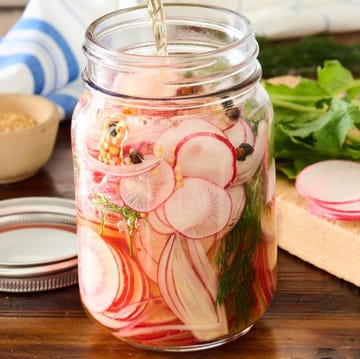Gardening woes got you down? You’re not alone. Even the greenest thumbs had to start somewhere—and their early mistakes often turned into their best lessons. Whether you’re growing your very first tomato or reviving a long-abandoned raised bed, it’s easy to fall into some common traps. The good news is, most gardening mistakes are totally fixable once you know what to look out for. “The key is to start small and stay curious,” says Carrie Spoonemore, co-creator of the From Seed to Spoon app. “Don’t try to grow everything all at once.”
That early-season excitement can lead to planting too much, too soon—and suddenly your garden is thrown into chaos. Timing is another biggie: Plant too early and risk a frost, too late and your veggies might not mature in time. “Use tools that pull from your local weather data so you're never guessing,” Spoonemore suggests. “You’ll know exactly when to plant, water, and harvest.” From poor spacing and underwatering to forgetting to harvest altogether (yep, it happens!), here are 10 common gardening mistakes—and how to avoid them for a healthier, happier garden.
1. Planting Too Much, Too Soon
That first warm weekend has a way of making us want to plant everything. But Spoonemore warns, “It’s easy to get excited and plant all the things, but that often leads to overwhelm and a garden that’s hard to manage.”
The best fix is to start small. Pick a few crops you actually love to eat and get to know their needs. You can always expand once you get more comfortable. A handful of well-tended plants beats a whole garden full of stress.
2. Not Paying Attention to Planting Dates
Gardening isn’t just about what you plant—it’s also when you plant. “Timing is everything,” Spoonemore says. “Plant too early and you risk frost damage; plant too late and your crops may not have time to grow.”
Instead of guessing, use tools like the Seed to Spoon app, which pulls from local weather data to help you plant at the right time for your area. It’s like having a garden coach in your pocket!
3. Overwatering or Underwatering
Watering seems simple…until your plants start drooping for reasons you can’t explain. “Both overwatering and underwatering stress plants,” Spoonemore explains. “Too much water can cause root rot, while too little leads to wilting and stunted growth.”
Her tip: Stick your finger into the soil. If it’s dry about an inch down, it’s time to water. Also, try grouping plants with similar watering needs together to make things easier.
4. Not Feeding the Soil
Healthy plants start with healthy soil. “Plants pull nutrients from the soil, and over time, it becomes depleted,” Spoonemore says.
Don’t rely on soil to magically stay rich on its own. Feed it regularly with compost, worm castings, or organic fertilizer. Think of it as a buffet for your plants—one that needs restocking now and then.
5. Poor Spacing
It’s tempting to squeeze in just one more plant—but overcrowding is one of the quickest ways to stunt growth and invite disease. “When plants are too close, they compete for sunlight and nutrients,” Spoonemore notes. “Plus, poor airflow increases the risk of fungal issues.”
Check seed packets for spacing guidelines, or use a visual garden planner to map things out before you plant.
6. Neglecting to Mulch
Bare soil might look tidy at first, but it dries out quickly and invites weeds. “Mulch helps retain moisture, protect the soil, and prevent erosion,” Spoonemore says.
Her go-to options are leaves, wood chips, or pine shavings. Skip straw—it can introduce weed seeds. A good layer of mulch also makes your garden look extra polished.
7. Not Tracking What You Planted (or When)
Once those seedlings take off, it can be hard to remember what’s what—or when you planted it. “It’s easy to forget, especially if you’re growing multiple varieties,” Spoonemore says.
The solution is to keep notes in a garden journal or use an app to log planting dates, harvest timelines, and any issues. That way, you’re not just growing plants—you’re growing knowledge for next season.
8. Not Thinking About Sunlight
Not all plants love the sun equally. “Some crops need full sun to thrive, while others are fine with partial shade,” Spoonemore says.
Before planting, take a day or two to observe how sunlight moves across your yard or balcony. Then match crops to their light preferences. Your sun-loving peppers and shade-tolerant lettuces will thank you.
9. Being Too Hard on Yourself
Here’s the truth: Sometimes, despite your best efforts, a plant just won’t make it. “Plants die—it happens to all of us,” says Spoonemore.
Instead of feeling discouraged, treat it as part of the learning process. Every gardener has a few flops under their belt (and probably a crispy basil plant or two). Celebrate your wins, learn from the losses, and keep growing.
10. Forgetting to Harvest
You’d be surprised how often gardeners forget to pick their produce—only to come back to overripe zucchini the size of baseball bats. “Leaving crops too long can lead to bolting or loss of flavor,” Spoonemore says.
Check your garden often, and don’t be afraid to harvest early and often. Many crops, like lettuce or herbs, will actually grow back faster when regularly trimmed.

Tierney McAfee is a freelance writer and Country Living and The Pioneer Woman contributor who covers entertainment, holiday & entertaining, food & drinks, design ideas, DIY, and more.













